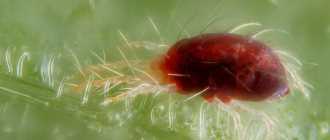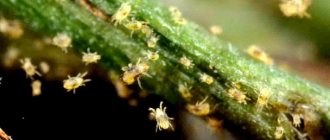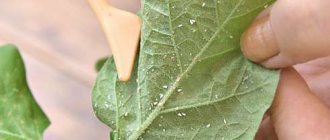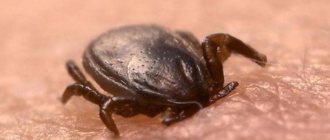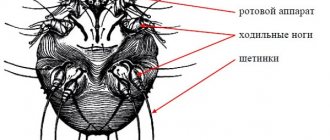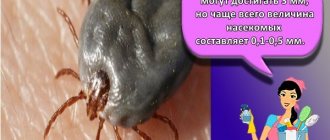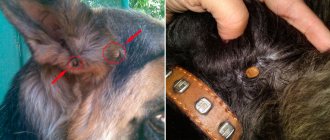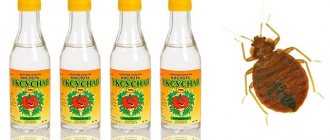Prevention measures
The main task of gardeners is to constantly monitor indoor plants.
Only in this case is it possible to notice the appearance of pests in time. We must not forget that all new flowers should enter the rooms only after quarantine measures, which usually last from 2 to 4 weeks. Treatment with folk remedies would also be useful. So, one of the main preventive measures is regular examination. The fact is that a pest can appear completely unexpectedly, being brought in, for example, through a window or clothes from the street. You can use glasses or a magnifying glass for inspection.
It is also very important to maintain a certain microclimate. Ticks feel most comfortable when the air in the house is dry and warm.
This is especially true in winter. Most often, plants are located on the windowsill; therefore, there are heating radiators nearby, which contributes to drying out the air.
Humidity can be maintained in several ways. For example, a florist can place basins of water around the apartment or use a special humidifier. Direct sunlight and drafts also have an unfavorable effect on ticks, so ventilation should be provided regularly.
Spraying should also be carried out. They help wash away cobwebs and also cause a lot of inconvenience for ticks. However, it is necessary not to overdo it, because there are also crops that do not like moisture, for example, violets.
The foliage of plants should be washed monthly under running water. To do this, the ground is covered with a waterproof film, and the bush itself is watered with water from the shower. The pressure should not be too strong, and the temperature should be between 25–35 degrees.
We must not forget that any soil should be disinfected. The most common methods are freezing and baking in the oven. These procedures make it possible to destroy not only larvae, but also eggs, even if they are initially invisible.
Fighting spider mites is a very complex and labor-intensive undertaking. It is not always effective, and in some cases the plant may simply die. Therefore, prevention and detection of the problem at its earliest stages are very important.
To learn how to deal with spider mites on indoor plants, watch the video below.
Types of predators
There are two types of predators:
- Phytoseiulus. It reproduces very quickly; the more active hunters are females, who are able to dine on more than 20 adult spider mites per day, while simultaneously laying 2-6 eggs. The females are quite mobile; having eaten all the pests in the accessible area, they move further. The eggs hatch into larvae, which are also considered the only food for the spider mite colony. Phytoseiulus loves high air humidity and average temperatures. The number of predators is calculated by eye, depending on how heavily infested the tree is and what size it is. For mild damage, 10 or 20 ticks will be enough, for medium damage, 30 to 50 individuals will be required.
- Amblyseius. It feeds not only on ticks, but also on thrips. It is very popular among greenhouse owners abroad. The only drawback of Amblyseius is that it is weakly capable of searching, that is, it feeds where it is planted. Therefore, it should be placed in close proximity to the colony. In addition, the density of predators and prey should be observed. Amblyseius is usually used for prevention.
The arsenal of methods to combat ticks is wide; it is most effective to use their combinations. If the collection of citrus fruits is large, it is worth considering biological methods as the safest, most effective and least troublesome.
Spider mites on indoor lemons are a common pest. It is very small and difficult to see with the naked eye. It is better to have a magnifying glass for such purposes. Spider mites feed on the juice of leaves of lemon, tangerine and other citrus fruits, making small holes in the leaves. Gradually, these leaves turn yellow, the tips curl up, dry out, and the leaves fall off.
As I already said, a mite on a lemon cannot be detected immediately, and most often we begin to sound the alarm when the entire plant is already covered in cobwebs. This is already a late stage of infection. It is important to learn to “see it” in the early stages of infection. Take a cotton wool soaked in alcohol or vodka and wipe the leaves of your citrus from the back and outside. You can see very small insects on them.
Reasons for the appearance of spider mites on indoor plants
Flower growers who grow a large number of different flora on windows or balconies sooner or later encounter tick attacks. Knowing the prerequisites for the occurrence of parasites in the house, you can prevent their appearance and secondary infection.
There may be several reasons for the abundance of ticks:
- A new plant from the store or borrowed from friends. It is better to keep new arrivals separately in so-called quarantine for 1-2 weeks.
- Open window. Residents of the lower floors are most at risk, as a colony of pests can reach them from the nearest tree. Flowers located on unglazed loggias are at risk. A person can carry ticks on clothing or the soles of shoes.
- Contaminated substrate purchased from a store. Another option is soil taken from a flower bed for replanting.
- Tanks and pallets that have not been used for a long time.
- Heating season in winter. In cold weather, females hibernate and become inactive until favorable conditions occur. Eggs can be in diapause for up to 5 years.
The gardener needs to inspect home plants daily, because with low humidity and high air temperatures, the mite population increases sharply. The female, despite her short life span, manages to lay 150-200 eggs in 2-3 weeks, the maturation time of which is 1-3 days.
Folk remedies
It is advisable to fight spider mites with “grandmother’s” means only if the pests have not yet proliferated greatly, otherwise the use of methods is ineffective.
Spraying
Most often, infusions, herbal decoctions and solutions made from products harmful to parasites are used in the fight against spider mites. The composition is poured into a container with a spray bottle and used for generous spraying of infected flowers. The procedure must be repeated every three to five days until the pests disappear. Five or more sessions are usually required.
To prepare the infusion, the raw materials are poured with boiling water, settled and filtered. The table below will tell you what and how to prepare the product.
Table - Infusions for processing flowers
| Ingredient | Concentration per 1 liter of boiling water | Infusion time (in hours) |
| Finely chopped onion | 1 onion | 4-5 |
| Onion peel | 6 g | 3-5 |
| Shredded potato tops | 100 g | 3-4 |
| Chopped stems and leaves of celandine (dry or fresh) | 2 tablespoons | 4-5 |
| Dandelion roots and leaves | 3 tablespoons | 3-7 |
| Capsicum | 50 g | 3-4 |
| Ground horse sorrel root | 50-60 g | 3-4 |
Herbal infusions are also used in the fight against ticks, although their preparation is more labor-intensive. Two remedies are most effective.
- From dry grass and yarrow flowers. Pour a liter of boiling water over 100 g of raw material, boil for three minutes, leave for three to four hours, filter.
- From the roots of cyclamen. Cut several tubers into cubes, pour boiling water over them, cook for 40 minutes, cool, filter.
You can also treat with solutions from the following table.
Table - Solutions for processing flowers
| Ingredient | Concentration per 1 liter of water |
| Ground sulfur-tar soap | 10 g |
| Hydrogen peroxide, 3% | 2 tablespoons |
| Potassium permangantsovka | 2-4 crystals |
| Pine extract | 8-10 g |
Another composition for spraying: pour wood ash with boiling water in a ratio of 1:10, leave for a day and dilute with water, maintaining a ratio of 1:2, add crushed laundry soap (4 g per liter).
Ash can harm flowers that prefer acidic soil: azaleas, camellias, heathers, rhododendrons.
Rubbing
This method is more time-consuming than spraying, but it allows you to remove a certain number of mites from the affected plant. The therapy is carried out in three steps.
- Preparation. Moisten a cotton pad or soft cloth with the prepared product.
- Treatment. Wipe the leaves and stems, rinsing the cloth frequently in the mixture.
- Repetition. Do the treatment every three to five days until the pests disappear completely.
The following products are used for wiping:
medical alcohol - in its pure form, applied in a thin layer so that the plant does not get burned (suitable only for hard-leaved plants: orchids, hibiscus, dieffenbachia, date palm); ammonia - 3 ml of the drug per 1 liter of water; rosemary essential oil - two to four drops per 1 liter of water; vodka - diluted with water in a ratio of 1:2.
Hot shower
The development of spider mites stops at temperatures above 40 °C: jets of hot water can wash off the pests from the leaves of the plant. The procedure is carried out in three steps.
- Preparation. Protect the pot with earthen substrate with a plastic bag so that hot water does not damage the roots.
- Temperature selection. Ideally, the water temperature should be approximately 44-47°C; for ficus benjamina, hibiscus or monstera, this figure can be increased to 52°C.
- Treatment. Wash the stems and leaves of the flower on both sides. Processing time is no more than three to four minutes.
First, you need to do three procedures with an interval of three to four days, then repeat the session once a week for a month, and then once a month for prevention.
A hot shower should not be used to treat indoor flowers with tender and drooping leaves. For example, violets.
Products for “delicate” plants
What to do if the plant cannot be sprayed, wiped or placed under running hot water (for example, succulents)? Resourceful gardeners advise using one of two methods.
- "Fragrant" greenhouse. Place a container with a product whose fumes are harmful to pests next to the pot, cover with a plastic bag, and leave for several hours. Finely chopped garlic or turpentine can be used as a “flavoring”.
- Home steam room. Transfer the plant to the bathroom, close the door, and turn on a hot shower, setting the water temperature to maximum. After eight minutes, when the room is filled with warm steam, you need to time it for 10-15 minutes and leave the flower in the bathroom for this time.
Remedies for spider mites (preparations)
Since mites, spiders and scorpions are not insects, insecticides are useless against spider mites. Effective drugs against arthropod pests are acaricides (Sunmite, Demitan, Omite, Flumite, Floromite, Nissoran, Bicol, Bitoxibacillin, Envidor, Apollo, Borneo) or insectoacaricides (Akarin, Agravertin, Vertimek, Dursban, Karate, Kleschevit, Fitoverm, Aktofit, Neo Ron , Talstar, Fufanon, Oberon). All these drugs are used in strict accordance with the instructions.
Plants are treated with chemical protection against ticks several times to ensure that the most persistent individuals and their eggs are destroyed. At a temperature of 20 ºC, at least three treatments must be carried out with an interval of 10 days, and at a temperature of about 30 ºC, 3-4 treatments are necessary every 3-4 days, otherwise the females that emerge from the eggs will have time to lay new eggs.
Unfortunately, among the listed drugs there are no ones that would be absolutely safe for humans, so it is better to prevent the appearance of pests. Make it a rule to regularly inspect your plants and carry out preventive spraying.
Various drugs
There are general rules for all drugs:
About the tools themselves:
Very poisonous drugs include those containing carbosulfan; it is better not to use them (Marshal drug).
Preparations in powder form do not always “stick” to plants well, so you can first spray the affected areas with stimulants (it is advisable to combine them with acaricides, that is, the above drugs), for example Epin or Zircon, and then treat them with powder.
Spider mites on indoor plants
Spider mites on an orchid
To protect orchids from spider mites, you need to create conditions for them that are as close to natural as possible. And even if you succeed, you need to constantly monitor the condition of the flowers, because the sooner you can detect pests, the easier and faster you will get rid of them. Optimal living conditions for ticks are air humidity of 30-40% at a temperature of about 27 ºC.
The red mite most often settles on the orchid, which is called false mite because it does not weave a web. This makes it more difficult to detect. He can enter the room with a new plant or a bouquet of flowers. After a tick bites, a silvery sheen appears on the orchid leaf, then the leaf turns yellow and falls off. You can find out whether there are mites on an orchid by placing a piece of apple on the substrate: after a while, all the pests will gather on it.
Each new flower must be inspected before being brought home. To prevent the spread of mites, wash your orchids regularly in a (relatively) hot shower. Orchids with tough leaves, such as cattleyas, can be wiped with a cotton swab dipped in rubbing alcohol, but test the alcohol on a small area of an old leaf first.
Since folk remedies are not always effective, and you don’t have to eat orchids, it makes sense to treat mite-infested plants with acaricides without wasting time.
Spider mite on lemon
You can determine that your indoor lemon has spider mites by the appearance of yellow dots on its leaves and yellowing of their tips. If you put a white leaf in a pot and shake the plant, and then look at the leaf under a magnifying glass, you can see mites. At a later stage, a thin web may appear on the lemon. The mite poses a danger to the lemon tree not only in itself, but also as a carrier of viral diseases, for which, alas, no cure has yet been invented. That is why, at the first sign of the presence of spider mites, you need to take immediate action.
After protecting the soil in the pot with a plastic bag, wash the crown of the tree with soapy fifty-degree water. As a result of the water procedure, there will be significantly fewer ticks on the lemon. You can protect lemon and other indoor plants from spider mites by placing a pot of geraniums nearby to repel these pests. Rosemary oil, the aroma of which pests cannot tolerate, helps protect lemons from ticks: dilute a few drops of oil in warm water and spray the lemon. Frequent but short-term exposure to ultraviolet rays repels ticks and strengthens plant immunity. To do this, you need to turn on the lamp for a couple of minutes every day.
But if, as a result of all these attempts, you have not been able to get rid of mites completely, treat the plant with an acaricidal preparation: Fitoverm, Actellik or Demitan. The last drug, which has an action period of 45-60 days, is especially effective against ticks on lemon. However, Demitan is toxic to fish, so you need to treat lemon as far as possible from the room with the aquarium. In addition, the drug is addictive and can only be used once. For subsequent treatments, which are carried out several times every 7-10 days, you will have to purchase other acaricides.
conclusions
We can summarize it like this: spider mites are a common insect, they are always nearby in one way or another , so do not create favorable conditions for their rapid spread if you suddenly have one. A warm, dry habitat is ideal for it. For prevention, you should spray the crown of citrus fruits with water, sometimes with the addition of rosemary oil. Plant geraniums and garlic next to the lemons. If you smoke, then sometimes smoke with lemon. And if you do notice a pest, then take measures immediately and apply chemicals according to the instructions. Repeat the treatment several times with a period of a week, while changing the drug so as not to cause addiction.
The cause of yellowing leaves can also be errors in the care and feeding of homemade lemons. You will also read the article with photographs from which you can determine by the leaves what is missing from a lemon or tangerine.
Means to combat spider mites
Each gardener chooses the best remedy for spider mites based on his preferences. For pest control the following are used:
- chemicals;
- biological methods;
- folk recipes.
Treatment can be supplemented with mechanical methods, for example, cutting off the affected parts of the plant, washing off parasites and cobwebs.
Chemicals
Industrial acaricidal and insectoacaricidal agents are considered the most effective in the fight against spider mites. Among them are:
- Actellik is an effective drug used to treat many types of plants;
- Apollo - most often used to treat berry crops, grapes, fruit trees, flowers;
- Anti-mite is an effective remedy for spider mites based on melathion (Anti-mite can be used outdoors and in greenhouses);
- Neoron – destroys eggs, larvae and adult ticks;
- Kleschevit - according to the instructions for use, this insectoacaricide is suitable for protecting fruit, berry, vegetable and flower crops growing both in open ground and at home;
- Tick beetle is an insectoacaricide of biological origin that destroys ticks, thrips, caterpillars, aphids and other pests.
When choosing a drug, it is very important to study the instructions or consult with the seller. The fact is that there are many varieties of mites and some drugs will be useless in the fight against pests that attack plants.
As an example, we can cite the products of the well-known brand “Reftamid anti-mite”. These products are intended to repel blood-sucking ticks or, like Reftamide Extra Anti-Tick, to kill ixodid ticks and blood-sucking insects.
Biological agents
Biological preparations against spider mites are made from natural ingredients, such as fungi or microorganisms. This explains their safety. Most popular:
- Akarin;
- Fitoverm;
- Bitoxibacillin.
Akarin
They effectively get rid of parasites without harming insects or crops.
Traditional methods
Among gardeners and gardeners, folk remedies for spider mites are very popular. They are not as effective as industrial preparations, but they are non-toxic and safe for people, insects and plants themselves. The most common methods:
- Garlic tincture will help destroy spider mites (pour 1 crushed head into 1 liter of water, leave for 3 days);
- onion peel (100 g of raw material, pour 5 liters of water, leave for 5 days, strain);
- a solution of laundry or tar soap (the leaves are washed with it, left for 2 hours, then washed off);
- herbal infusions (dandelion, calendula, celandine, yarrow, wormwood) are filtered before spraying the plants.
A rather unusual, but according to many, an effective way to remove spider mites is to treat the affected plant with Coca-Cola or Pepsi-Cola, having first gotten rid of the gas.
Features of the pest
The spider mite looks like a small elliptical spider. It is difficult to see the small parasite, especially since its color (light green, brownish or whitish) provides excellent camouflage. Less common are red or orange varieties.
Varieties
There are more than 1,200 species of spider mites. Only some of them can attack indoor flowers. The table below reflects the characteristics of the most common species dangerous to houseplants.
Table - Varieties of parasites dangerous for indoor flowers
| View | Body length | Color | Preferences | Peculiarities |
| Ordinary | 1 mm | Pink or reddish | - Dracaena; - fuchsia; - rose; - palm trees; - balsam; - citrus fruits; - ficus | Omnivorous, can settle on almost any plant |
| Red | 0.3-0.5 mm | Red (males) or purple-red (females) | - Rose; - balsam; - orchid; - calla lilies; - lemon; - nightshades; - cineraria; — muraya | — The higher the air temperature, the faster it multiplies; - difficult to tolerate high humidity |
| Atlantic | 1 mm | Yellow-green | — Palm trees; - citrus fruits | Loves high humidity |
| Cyclamen | 100-300 microns | — Balsam; - chrysanthemum; - pelargonium; - gloxinia; - violet; - gloxinia; - tuberous plants | Translucent or yellowish | — Impossible to see with the naked eye; - concentrated on the upper side of the sheet; — as the colony grows, the parasites look like a layer of dust; - prefers high humidity |
| Wide | 0.25-0.4 mm | Brick or yellow | — Most varieties of cacti; - ficus; - euonymus; - oleander; - Saintpaulia; - citrus fruits; - aucubus | — Invisible to the naked eye; - large accumulations look like reddish-brown dust |
| Cactus (bryobia) | 0.8-1 mm | Reddish | Exotic plants | — Moves quickly throughout the plant; - lays large orange eggs |
| Clover | 0.6 mm | Greenish or brown | — Euonymus; - ficus; - bulbous plants; - orchids; - peperomia | Produces quickly in high humidity |
Life activity
Pests usually “live” on the back of the leaf, in lumps of soil, under fallen leaves. The difficulty of controlling arthropods is determined by three factors.
- Fertility. The lifespan of a female tick is less than a month, but every three days she lays about a hundred eggs. This is why pests “occupy” the plant in entire colonies.
- Vitality. Pest eggs can remain dormant for up to five years. And not only on the leaves and stems of the plant, but also in the crevices of the windowsill, flower tray, and chipped flower pots. Under unbearable conditions, females bury themselves in the ground or hide in secluded places, falling into a special state - diapause, when vital processes slow down.
- Inconspicuousness. Often the presence of an insect is detected when the condition of the plant noticeably deteriorates as a result of the activity of parasites.
The parasite travels from egg to adult in about a week. The egg stage lasts three days, the larval stage lasts one day, and the nymph stage lasts four days.
Reasons for appearing in the house
Experts identify three reasons for the appearance of the pest on indoor plants.
- Buying an infected plant. Most often, flower growers bring pests from the store.
- Entry through a window. If there are green spaces on the street near the house, there is a high probability of indoor flowers being damaged by mites, which are carried in by gusts of wind through an open window, especially if the apartment is located on the lower floors. If the plants are taken out onto the balcony for the summer, the process is simplified.
- Use of contaminated soil. Unscrupulous suppliers sell soil contaminated with larvae and eggs of parasites. You can bring pests along with the soil from your garden plot.
Symptoms of infection
Due to the small size of the parasites themselves, it is difficult to notice without setting such a goal. Usually the presence of pests is announced by the consequences of their life activity. Two signs will help to suspect a plant infection.
- Putin. The leaves of the plant are covered with a thin web.
- Leaf changes. First, whitish or yellowish spots appear on the bottom of the leaf, then the leaves dry, curl into a tube and fall off.
If the described signs are detected, it is necessary to carefully examine the plant: if you try, small insects can be noticed, especially if their numbers are high. The accumulation of arthropod bodies looks like a layer of dust.
Main lemon pests and signs of appearance
The appearance of insects on cultivated plants does not depend on careful care. In the warm season, parasites enter a person’s home from open windows, in the fall and winter - on bouquets, new flowers or from contaminated soil. Homemade lemons have many pests, the signs of which must be recognized.
Aphid
A small, sedentary bug feeds on the intercellular sap of plants and spreads viruses. Representatives of the species have a tiny body (up to 5 mm) and color from light yellow to deep black. Green aphids are more common in apartments.
Parasites on lemons gather in colonies on the underside of leaves, quickly multiply and spread throughout the plant. In places where they accumulate, the plates become deformed and bend. You can recognize an insect by:
- sticky coating on greens;
- crawling ants;
- unhealthy appearance of the tree.
Whitefly and its larvae
Small moths have opaque wings covered with a white coating. Adults are not dangerous to citrus plants. The voracious young hatch from eggs laid on the underside of the plates. The parasites feed on the cellular juice of the lemon and leave a sticky coating. Sweet drops become an excellent environment for the development of sooty fungus. The disease covers large areas and impairs photosynthesis.
Whitefly larvae can be recognized by their greenish bodies, shaped like small grains. On the affected plant, the foliage is covered with white spots from bites. If you do not fight the pest, the plates turn yellow, dry out and fall off. Insects are very dangerous during citrus blossoms.
Thrips
Small parasites are not noticeable in the first stages of invasion; they quickly multiply and spread throughout indoor lemons. Adults and larvae feed on the sap of the plant, leaving white marks and silvery streaks. The foliage brightens, falls off, the buds lose their shape and become covered with dark spots. The affected specimen weakens and stops developing.
Spider mites
Dangerous pests live and reproduce during heat and dry air. In conditions of high humidity, females hibernate. Insects burrow into the ground, hide in cracks in frames or under fallen greenery. Adults wake up after the restoration of a favorable microclimate.
The tiny parasite is invisible to the naked eye. You can recognize a tick by small holes in the leaves and thin cobwebs between the shoots. Affected lemons turn yellow and brown, curl and fall off. Photosynthesis processes are disrupted, growth and fruiting stop.
Scale insect and false scale insect
Dangerous pests of indoor plants produce up to 3 generations during the season. Insects on the foliage look like a seal located along the veins of the plates. Adults are immobile, but young animals migrate quickly, spreading the infestation. You can recognize the type of parasites by color and shape:
- false scale insects – oval dark brown;
- Scale insects are round gray.
Mealybug
Externally, the insect resembles a huge aphid, covered with a white, loose coating. Pests quickly spread throughout the lemon, weakening the plant and leaving sticky drops on the foliage. The affected citrus develops poorly and withers. When neglected, dark spots of sooty fungus appear.
Nematodes
Small worms feed on lemon roots, so they are difficult to notice with the naked eye. Males have an elongated body, females have a spherical body. Under unfavorable conditions, the eggs sleep in the ground for a long time. The affected parts are covered with swellings that turn into necrosis. The foliage loses turgor and turns yellow. Indoor trees stop growing and die.
Springtails or springtails
Tiny jumping insects appear in the soil with high humidity, poor drainage and the use of organic fertilizers. Light-colored arthropods feed on rotting plant debris and move quickly. Springtails are not dangerous to home flowers, but in large numbers they can damage the roots. The abundance of scurrying worms indicates mistakes in caring for citrus.
Sciarids (midges)
Soil mosquitoes have a narrow winged body and a round head. Adults do not feed, and young animals eat rotting plant debris. Externally, young sciarids resemble ringworms, with a translucent body and a noticeable digestive system.
During mass reproduction, there is not enough food, so the larvae eat the roots and green parts of the plant in contact with the ground. Insects prefer a moist environment and an abundance of organic matter. They leave behind a sticky, slimy trail on the soil surface. If you take the worms out of the ground, they die within 5 minutes.
Destruction methods
It is quite difficult to fight spider mites, so measures to exterminate them must be comprehensive. It is good, for example, to combine chemical remedies with folk ones. A previously infected plant must be cleaned with special care using soapy water and watered abundantly; this will significantly reduce the number of insects.
Then use the products depending on the degree of infection.
Traditional methods
If the damage to the plant is not yet too severe, you can try using folk remedies to combat ticks:
- Finely chop two heads of garlic and add a liter of water and leave for five days. Before spraying, dilute the solution with the same amount of water;
- Pour one hundred grams of onion peel into five liters of water and leave for five days. Then strain the solution and spray the plant with it several times until the pests completely disappear;
- Periodically wash the foliage of plants with water and laundry soap or Fairy soap - to do this, you need to put the plant in a bath and soap the leaves, branches, pot and tray with soap using a sponge, the ground should also be sprayed with soapy water, but do not spill it so as not to get on the roots. Do not wash off the foam for 3-4 hours, but no longer, then rinse well and cover the flower with a bag for a day;
- Chop several cyclamen tubers and cook for 40 minutes, then wrap and leave for 24 hours. Treat flowers with this infusion several times a week;
- Medical alcohol - wipe the leaves of the plant, the mite will be destroyed, but the eggs cannot be destroyed in this way;
- The roots of medicinal dandelion in the amount of 30 grams are crushed and poured with a liter of water. Leave for three hours. Spray the damaged rose several times;
- Biological control with the help of insect predators that are not averse to eating spider mites. These insects include: phytoseiulus, amblyseius californica and mackenzie, metaseiulus and common goldilocks. You can buy them in specialized stores or greenhouses. One predator eats up to five spider mites or ten eggs per day, so the more predators there are, the faster you can get rid of the pests.
Chemical methods
Now there are many chemicals that can quickly get rid of cobwebs on indoor roses and the pests that create them. The main ones are acaricides: Neoron, Fitovern and Actellik. These remedies can help you completely get rid of harmful insects in less than a week.
Actellik is the most effective and toxic remedy. Therefore, when processing, you need to wear gloves, closed clothing and a mask. The drug should be used in a well-ventilated place. Photoverm is less toxic and can be processed indoors, but the effectiveness of the product remains at a high level
Within five days after treatment, the tick must be completely exterminated. Despite the lower toxicity, it is also important to take precautions when working with this drug. Neoron – perfectly destroys adult ticks and their larvae. To completely eradicate insects, at least two plant treatments are necessary.
Since the use of chemicals is most effective against adult insects and already hatched larvae, and laid eggs are not so easy to destroy, treatment with any means must be carried out 2-3 times.
All the methods described above are used if the rose is covered with cobwebs in winter or late autumn. In the warm season, if possible, it will be easier to plant it in open ground, where ants and their other enemies will deal with the pests. And fresh air, sunlight and rain will be the best cures for spider mites.
Biological method
The only enemy of the spider pest is the predatory mite Phytoseiulus persimilis. Its main and almost only food is spider mites. This predator is completely safe for humans, pets and plants. Using a mite against its kind is easy and pleasant; there is no need to waste time on tedious running around with spraying, soap, wrapping plants with film or washing clothes after treatment. In a day, the predator is able to find and eat 5 mites or 10 eggs, and it works ahead of the curve; spider mites reproduce more slowly. True, as soon as the entire population of spider mites dies, the predator also dies for lack of food.
Types of ticks and danger
Such small pests settle on home plants in accordance with their taste preferences. Some people cannot tolerate aloe, others cannot tolerate plants of the Gesneriaceae family, etc.
The number of species of ticks exceeds several thousand, the most common of which are:
- Common or white mites are light-colored spiders, the most dangerous and widespread, living on the back of leaves and young shoots. When they multiply strongly, they are able to crawl onto neighboring plants. The first sign of their appearance on a flower: yellow spots and a thin web that entangles green shoots and leaves.
- Red mites are microscopic brightly colored insects that attack indoor orchids, roses, and lemon trees; are among the most dangerous and rare.
- Flat cactus or bryobia - affect exotic plantings, leaving yellow dotted stripes on the greenery, the eggs are orange, and the clutch is located in a chain along the leaf veins.
- False mites are the smallest even among their fellow mites, which is why they quietly damage plants, which become covered with cobwebs and quickly wither.
- Cyclamenaceae - settle in the soil, in tubers and on plant leaves; outwardly, their colonies look like dust, which makes detection difficult.
Reproduction of ticks
Several generations live in the web they create. Ticks multiply at tremendous speed. Fertile females lay many round eggs. At first they are almost transparent, but after a while they become yellowish cloudy. The rate of embryo development depends on temperature. At +15 degrees - 15 days, at +30 - only two to three days! The full cycle occurs: from 30 to 36 days, if conditions are unfavorable, from 7 to 8, if conditions are good.
It becomes clear that the fight against spider mites on indoor plants should begin as early as possible. At low temperatures and high humidity, the larvae slow down their development. As conditions improve, mass infection occurs. Considering that spider mites quickly move to healthy plants, you need to know how to get rid of the mite in order to prevent the mass death of green pets. What harm do spider mites cause? When damaged, the plant becomes weak.
Signs of plant damage:
- the underside of the leaves is strewn with small dots;
- the entire plant or individual parts are intertwined with cobwebs;
- in case of severe damage, swarming pests can be seen in the web.
Spider mites carry:
- viral infections;
- gray rot spores.
Prevention and home remedies
All mites do not tolerate moist air well, so frequent spraying and periodic warm showers for plants are a good preventative measure. Timely removal of faded buds and old yellowed leaves may be useful. Mite eggs can retain live larvae for five years, so even with the apparent complete destruction of pests, there is always a risk that they will infect a plant or a collection of crops. Therefore, it makes sense to monitor the sterility of the soil when replanting a flower or washing its roots.
Conditions suitable for lemon, sufficient lighting, timely replanting and pruning, periodic spraying with stimulants (Epin) will ensure that pests, even if they exist, will not be able to cause significant harm to the plant simply because the walls of the vessels are strong, elastic and quickly regenerated. Temporary or long-term violation of care conditions (withered leaves, heat, dryness, draft) - and mites quickly occupy the weakened plant.
It is not always possible to use strong drugs at home, for example, there may be children in the house or there is no way to properly ventilate the room
Please note: no “home” method can guarantee complete destruction, since the mites are very small. The following will help to partially cope with the pest on the lemon tree:
Medical alcohol 96%. It will only get rid of adult pests; eggs cannot be destroyed, but with regular treatment it is possible to reduce the pest population. It evaporates quickly, so it does not damage the green mass, but it is not suitable for plants with thin leaves (lemon leaves are quite dense). Green soap. This is a special substance, environmentally friendly and completely safe for plants. Dilute soap in a proportion of 200 g (4 tbsp) per 10 liters of water
It is necessary to carefully spray the lemon tree with the resulting solution, paying special attention to the nodes, the underside of the leaves, and the axils. When processing, the pot should be covered with film, since soap, when it gets into the soil, disrupts its acidity. Laundry soap
Use a sponge to whip up foam and apply to leaves and branches. Leave for 3-4 hours, the soap will dry, forming a film. It is not very well tolerated by the plant itself, so the soap should be washed off, and the still wet flower should be wrapped in film and left overnight. The next morning you need to let the plant breathe and then repeat the procedure. This sequence is repeated at least three times. It is advisable that soapy water does not get on the ground, although spraying the surface layer cannot harm the roots. You should absolutely not spill soapy water on a clod of soil; most likely, the lemon will die. Dishwashing liquid. Effects on pests no worse than soap. It is advisable to take a product for treating children's accessories. The procedure is similar to that described above. In any case, if you wash the leaves of the plant, this will remove more than half of all mites. Be sure to disinfect the pot and the place where the plant stood. Garlic infusion and onion juice. Due to the characteristic odor, they are rarely used. The garlic infusion is prepared as follows: chop 2 heads of the vegetable, add 1 liter of water, leave for a week. The resulting infusion is diluted with water 2 times and the affected leaves are wiped.
Aphid on lemon
Aphids are small, inactive, sucking pests of lemons. Aphids can have different colors - from yellow to black, but most often aphids are green.
Aphids suck juices from plants, preferring young leaves, flowers and buds. Aphids stick to the leaves in entire colonies, feed and multiply quickly. Often, aphids are raised and milked by ants—if you spot an aphid, look for the presence of ants.
Aphids are a nasty pest that weakens plants and transfers viral diseases from one plant to another. For example, aphids often enter the house with a bouquet of roses or chrysanthemums purchased in a store, which means they can transfer greenhouse viruses to your plants. Therefore, as a preventative measure, it is not recommended to place vases with purchased flowers in rooms where lemons grow.
Aphids graze on the undersides of leaves, forming colonies. Lemon leaves curl or curl, become discolored, and become thin. When feeding, aphids secrete a sweet liquid - "honey" dew - so the leaves become sticky and sticky. By the way, the ants collect this liquid and carry it to the anthill. Lemons affected by aphids stop growing and look bad.
How to fight aphids on lemon. Having identified aphids, thoroughly wash the leaves, branches and trunk of the lemon with a soap solution, dissolving 30 grams of laundry soap in 1 liter of water.
Leaves need to be washed on both sides. It is advisable to cover the soil with film and tie the trunk with a bandage so that soapy liquid does not get inside the pot.
After washing the plant with soap, proceed to treatment with chemicals or folk remedies to combat aphids, for example:
- Infusion of tobacco. Pour 1 liter of tobacco or shag (50 grams). water and leave for one day, and then boil the infusion for 2 hours. Dilute the resulting tobacco infusion with one liter of water. Apply the infusion to the leaves and stems of the plant, wetting the surface evenly.
- Infusion of onion peel. Pour onion peel (30 grams) into 1 liter of water, leave for 5 days, and then strain. Apply the onion infusion, evenly irrigating the leaves and stems.
- Garlic peel infusion. Pour 3 liters of water over the garlic peel (40 grams) and let it brew for a day, and then process the leaves and stems of the lemon.
- Mustard infusion. Pour dry mustard powder (70 grams) into 1 liter of boiling water and stir thoroughly to break up the lumps. Leave the resulting slurry for 3 days, tightly closing the lid. Before spraying the lemon, dilute the suspension in water in a ratio of 1:3 (one part mustard infusion, three parts water).
- Dandelion infusion. Pour dandelion roots (30 grams) or leaves (50 grams) with 1 liter of warm water (+50 °C) and leave for 4 hours, then strain and thoroughly spray the lemon tree.
- Infusion from potato tops. Pour green or dried tops (150 grams and 75 grams, respectively) of potatoes with 1 liter of hot water and let it brew for 3 hours and strain. The infusion of potato tops is not stored, but used on the day of preparation.
- Infusion from tomato tops. Pour half a kilo of green tomato tops with one liter of water and boil for 30 minutes over low heat, strain and dilute with water in a ratio of 1:3. Spray the lemons thoroughly.
Attention: Infusions of onion and garlic peels, mustard and dandelion can be used when lemons are infected with spider mites.
Fighting spider mites
If there are spider mites on indoor plants, how to fight them, taking into account the development and wintering characteristics of the pest? How to get rid of mites on indoor plants most effectively? First of all, it is necessary to take preventive actions.
It is also necessary to collect fallen leaves, remove faded flowers in a timely manner, feed with potassium and phosphorus fertilizers, spray or bathe the plants in the shower. Be sure to quarantine new plants and always sterilize the soil.
Methods of struggle with folk remedies:
- treat the plants with water and laundry soap;
- Once every 7 days, irradiate with an ultraviolet lamp for 1.5-2 minutes;
- spraying: infusion of onion, dandelion, tobacco, cyclamen tubers, pyrethrum or wormwood.
Save the rose and lemon
Which plants most often suffer from pest attacks? And if a mite appears on indoor flowers, how to get rid of the pest? The domestic rose is very susceptible to this scourge. What drugs to use, how to get rid of spider mites on a rose to prevent mass infection?
"Neoron" is a universal drug that will help destroy adults and larvae.
Just two steps are enough and the spider mite on the indoor rose will disappear. The drug "Fitoverm" also works effectively. The plant can be processed even indoors. As a rule, after five days the mites disappear.
How to destroy spider mites on roses, how to deal with them if the rose has been massively infected. The most effective remedy is the drug "Actellik". It must be remembered that the product is very toxic! It is better to carry out processing in a well-ventilated area and protect the skin of your hands.
Lemon is also susceptible to spider mite infestation. This is a delicate plant, therefore, spider mites on lemon, affecting young leaves and immature shoots, bring big problems to it. Lemon quickly becomes ill and may die.
If there are spider mites on a lemon, how can you fight it so that the tree doesn’t disappear? There are several ways:
- Spray with sulfur.
- Treat the plant for 1-2 minutes with a special ultraviolet lamp for 1.5-2 minutes.
- Wipe the leaves with a cotton swab moistened with a 96% alcohol solution.
- Use 35% Sulfarid paste. Treat the tree 3-5 times. You cannot treat with Sulfaride paste during flowering and at the stage of fruit set.
What is the most effective remedy for spider mites on indoor plants? Unfortunately, there is no such remedy to destroy all pests at once. As a rule, it is necessary to do not one, but several treatments before all the mites are destroyed.
The most popular pests of citrus crops
Scientists say that there are a huge number of insects on earth. Many of them play an important role in nature. While others cause irreparable harm. Therefore, they have to be dealt with in various ways.
Most often, citrus crops are affected by:
- spider mite;
- aphid;
- scale insect;
- mealybug.
Unfortunately, pests of citrus crops try to live an inconspicuous existence. They camouflage themselves in every possible way against the background of dense greenery, shoots and even the root system. However, attentive gardeners can easily remove their masks and then shoot them with reliable weapons.
At home, it is not always convenient to use chemicals to kill pests. Therefore, experts recommend constantly monitoring the plant in order to neutralize them in time.
Spider mites are in a hurry to feast on “vitamins”
Insidious pests approximately 0.4 mm in size settle on the back side of the leaf blade.
Outwardly, they resemble miniature spiders that sit serenely on the plant. It is almost impossible to notice them with the naked eye. Only thin threads of the web indicate their presence and activity. But how to deal with spider mites on citrus plants so as not to harm the crop. If you do not respond to the presence of insects in time, the leaf blades will first become covered with white-yellow spots, then turn yellow, curl and fall off.
There are several ways to eliminate spider mites:
- sulfur in powder form is poured into a small gauze bag and sprinkled on all parts of the plant;
- Laundry soap is diluted with water and a generous “shower” is given to the affected foliage;
- since spider mites are afraid of ultraviolet radiation, the culture is placed for several minutes under a special lamp;
- the affected areas are treated with isopropyl alcohol, which kills uninvited guests.
When using alcohol to combat mites, you need to carefully wipe the back of the leaf with a cotton swab to avoid burns.
In addition, stores sell special preparations to kill spider mites. They are not only of a chemical nature, but also of natural origin. After the procedure, the culture is carefully monitored. Some eggs may remain alive, leading to the resurgence of pests. For prevention, the complex is repeated after 5 days. One drug is used no more than 4 times, since ticks quickly get used to it, developing immunity.
Soft-bodied aphids and “sweet” citrus juice
If you enlarge this insect several dozen times, it may seem quite cute. However, the appearance of aphids on homemade lemons brings many problems to gardeners. The insect reproduces quickly, so it needs an abundance of food. Entire colonies of aphids cling to the tender shoots of the plant and actively suck the juice out of it. To prevent pest attacks, the tree is washed with warm water.
When performing the procedure, it is advisable to cover the soil of the flowerpot with film.
When aphids first appear, use a soap solution. It is prepared from laundry, tar or green soap. Add 10 g of raw material to 1 liter of warm water. Then, using a cotton swab, carefully wipe the affected areas of the citrus crop. A week later the procedure is repeated. Thanks to this, the soft-bodied aphid on the lemon, the photo of which is shown above, will disappear forever.
Garlic water helps get rid of the pest. It is prepared simply:
- chop the head of garlic;
- pour a glass of boiling water;
- leave for 48 hours.
The solution is used to spray the tree for a week at intervals - every other day. But how to treat lemon against pests to get instant results? A reliable remedy is Dichlorvos. Before the procedure, the culture is placed in a plastic bag. Then cotton wool, generously moistened with the preparation, is placed there, closed and kept for about 5 hours. The treated leaves are thoroughly washed with clean warm water.
The dangerous “criminal” of citrus crops is the scale insect.
The first sign of a pest is considered to be bulges on the leaf blades and branches of the plant. On average, their length reaches 4 mm, which is visible to the naked eye. Usually insects choose suitable places and stick to them. The provided photo of a scale insect on a lemon clearly demonstrates the vital activity of this pest.
Biologists distinguish several types of scale insects:
- black;
- spotted;
- yellow-brown;
- patterned;
- oval;
- round.
Since the insect creates a waxy shield around itself, it is quite difficult to fight. Therefore, the first sign of the presence of scale insects on a tangerine is sticky leaves that resemble sweet syrup. Over time, the culture weakens and may dry out completely.
Chemicals will help get rid of a dangerous enemy:
- "Aktara";
- "Fitoverm";
- "Aktellik".
After treatment, the crop absorbs the insecticide, and its juice becomes fatal to the scale insect. The procedure is carried out at least 3 times with an interval of 15 days. The top layer of soil is removed, replacing it with fresh soil.
Unfortunately, the fruits of the processed crop are unsuitable for food.
You can fight scale insects in other ways. For example, lemon or tangerine leaves are washed several times a day with tobacco tincture (50 g of raw material is diluted in 1 liter of warm water, left for 2 days).
Also, the affected leaves are treated with a solution prepared from the following components:
- Anabasine sulfate;
- green soap;
- warm water.
After a day, it is washed off with clean water. The procedure is repeated after 7 days. An equally effective remedy is a kerosene-soap emulsion, which is used to spray citrus crops 2 times a week.
The mealybug is a master of camouflage
When someone finds worms in tangerines, the desire to eat them immediately disappears. Therefore, when growing citrus trees, it is important to carefully protect them from pests. A mealybug attack is manifested in sugary secretions and a fluffy coating on leaf blades. Of course, the insect is wonderfully camouflaged on the crop, and you won’t notice it right away.
It sucks juice from the following parts:
- young shoots;
- blossoming buds;
- leaves;
- root system.
This leads to slow growth of citrus fruits and fruit damage. If larvae are observed in oranges, then the tree is infested with pests.
When growing exotic plants at home, it is especially important to control the humidity of the room. Its maximum level is up to 80%. Dried buds and leaves are immediately removed to prevent the mealybug from settling. In case of crop damage, special chemicals are used (Decis, Karbofos). Folk remedies made with green soap, garlic and tobacco are also especially popular.
As you can see, no matter what pests of citrus plants you have to fight, there is always a chance to emerge victorious. To do this, it is important to know your enemies well: habits, appearance and places of “deployment”. As well as effective methods of struggle. Not a single dangerous insect can resist such a weapon.
